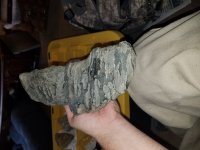Derk
Jr. Member
- Sep 30, 2018
- 45
- 45
- Primary Interest:
- All Treasure Hunting
Or was that the 1st rule of Meteorwrongs?
Either way, someone here should be able to set me straight with these two pieces I found about 25 yards apart in a field. Didn't even realize until I got them home and cleaned up that they fit perfectly together! I was shocked to have found and decided to keep 2 separate and kind of different looking(initially) stones to carry home for a closer look, then find they were both parts of the same original stone!!
When together, they both have some flat sections of the melt/flow lines on the same side/face as one another, but these flattened portions are not on the same plane though, despite having the same orientation. There are at least 3 planes of flattening, all on the same face/side/edge. This seems to suggests that whatever caused the flattening of the "melt" flows there, probably occurred before the separation, while they were still together in one piece. Also the smaller(top) segment has a larger cross-section than the larger piece even though they share the entire fracture point from where they separated. That, along with the misaligned "flat-melted" planes, and the way the fracture face on both segments, is edged all the way around with a rounded wear/erosion/ablation termination that looks like it happened after the separation, and independently continued on each piece after they separated, is what makes me think they may have occured at high temperatures whilst traveling through air. I'm not sure, but this much I DO know to be true: I couldn't know that to be true, even were it were to have been, as that.
That's why I need this Forumers' help identifying just what this thing is. Hopefully, none of my way of describing all that, will make any bit sense to anyone, and will not need to, since the pictures will instantly be recognizable to enough of you, as to identify exactly what these 2 fragments are, and such can easily be described in terms that even I would choose to make sense of.
If anyone has any questions, teasing or not, please feel free to lob 'em at me. I should be able to answer anything that doesn't require me to know anything as it relates to the geomorphical sciences.
That said... Here are some pictures that I will use to justify my ignorance in throwing out terms I clearly have no business using, like "Anorthosite" and "Cataclastic" only because Ive heard them used to describe Meteorites that I know nothing about.
So to anyone kind enough to overlook all that I have said thus, and willing to offer any actual knowledge that might shed light or invite levity or right any wrong whatsoever, please feel free to do so. Thanks.
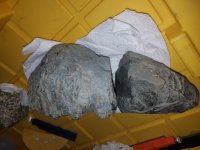
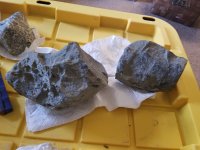
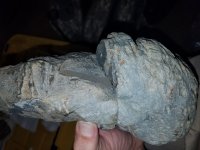
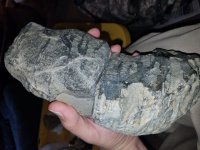
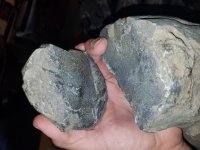
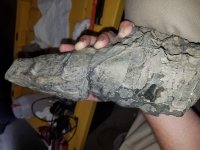
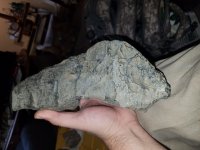
Either way, someone here should be able to set me straight with these two pieces I found about 25 yards apart in a field. Didn't even realize until I got them home and cleaned up that they fit perfectly together! I was shocked to have found and decided to keep 2 separate and kind of different looking(initially) stones to carry home for a closer look, then find they were both parts of the same original stone!!
When together, they both have some flat sections of the melt/flow lines on the same side/face as one another, but these flattened portions are not on the same plane though, despite having the same orientation. There are at least 3 planes of flattening, all on the same face/side/edge. This seems to suggests that whatever caused the flattening of the "melt" flows there, probably occurred before the separation, while they were still together in one piece. Also the smaller(top) segment has a larger cross-section than the larger piece even though they share the entire fracture point from where they separated. That, along with the misaligned "flat-melted" planes, and the way the fracture face on both segments, is edged all the way around with a rounded wear/erosion/ablation termination that looks like it happened after the separation, and independently continued on each piece after they separated, is what makes me think they may have occured at high temperatures whilst traveling through air. I'm not sure, but this much I DO know to be true: I couldn't know that to be true, even were it were to have been, as that.
That's why I need this Forumers' help identifying just what this thing is. Hopefully, none of my way of describing all that, will make any bit sense to anyone, and will not need to, since the pictures will instantly be recognizable to enough of you, as to identify exactly what these 2 fragments are, and such can easily be described in terms that even I would choose to make sense of.
If anyone has any questions, teasing or not, please feel free to lob 'em at me. I should be able to answer anything that doesn't require me to know anything as it relates to the geomorphical sciences.
That said... Here are some pictures that I will use to justify my ignorance in throwing out terms I clearly have no business using, like "Anorthosite" and "Cataclastic" only because Ive heard them used to describe Meteorites that I know nothing about.
So to anyone kind enough to overlook all that I have said thus, and willing to offer any actual knowledge that might shed light or invite levity or right any wrong whatsoever, please feel free to do so. Thanks.







Amazon Forum Fav 👍
Attachments
Last edited:






